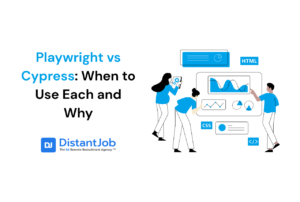You’re gearing up to develop a dynamic new app for your business, and you want it to excel on multiple platforms without too much headache. So, which technology should you choose? Flutter or React Native? As you stand at this crossroads, know that the decision could significantly influence both the performance and cost-effectiveness of your app.
According to Statista, Flutter and React Native are leading the charge in cross-platform mobile app development. Rising adoption rates speak to their robust capabilities and growing preference among developers worldwide. Each offers distinct advantages and comes with its own set of challenges.
Understanding these differences is crucial, not just for making an informed decision but also for ensuring that your app aligns perfectly with your business goals.
Let’s delve into a detailed comparison to determine which framework—React Native or Flutter—stands out in terms of performance, cost efficiency, and more. This decision is more than a technical choice; it’s about setting the stage for your project’s success.
Key Differences: React vs Flutter
React Native and Flutter differ significantly in their core technologies and practical applications. React Native uses JavaScript, making it accessible to a wide range of developers, while Flutter employs Dart, which is less common but optimized for smooth, high-performance user interfaces.
Architecturally, React Native integrates JavaScript with native components, which can introduce performance bottlenecks, whereas Flutter compiles directly to native code, enhancing efficiency.
Practically, React Native often leads to faster market deployment due to JavaScript’s ubiquity and extensive libraries. However, Flutter is quickly gaining ground with its robust widget library and growing developer community, supported by Google’s strong advocacy and resources.
| Comparison | React Native | Flutter |
| Release Date | March 2015 | May 2017 |
| Founder | ||
| Programming Language | Javascript | Dart |
| Type | Software Framework | Software Dev. Kit |
| License | Open-source | Open-source |
What Is React Native?
React Native is a powerful open-source framework that merges native development with React, a JavaScript library designed for building user interfaces. Developed by Facebook in 2015, React Native allows developers to create genuine Android and iOS applications using JavaScript and React—technologies traditionally associated with web development—instead of Java or Kotlin.
Advantages of Using React Native:
- Vast Community Support: As a framework backed by Facebook and widely adopted by developers around the world, React Native boasts a robust community. This extensive network provides ample resources, shared knowledge, and troubleshooting support, which can accelerate development and reduce problem-solving time.
- Rich Libraries and Ecosystem: The framework is supported by a plethora of libraries and tools that enhance its functionality and simplify various development tasks. This rich ecosystem means developers can easily implement features and integrations.
- JSX Support: React Native uses JSX (JavaScript XML), which allows developers to write their UI components using a syntax that resembles HTML. This makes the code easier to understand and maintain, especially for those with a background in web development.
Use Cases Where React Native Excels:
- Single-Page Applications (SPAs): React Native is particularly effective for developing SPAs where seamless user experiences and fast load times are crucial. Its ability to manage state transitions and view updates dynamically makes it an ideal choice.
- Complex UIs with Dynamic Data Updates: Applications that require real-time data updates and complex user interactions can benefit greatly from React Native’s efficient handling of stateful, data-driven interfaces. This makes it suitable for apps like social media platforms, e-commerce apps, and financial dashboards.
React Native’s capabilities have been leveraged in several high-profile apps such as Facebook, Instagram, and Bloomberg, underscoring its versatility and robust performance across diverse use cases.
What is Flutter?
Flutter is an open-source UI software development kit created by Google, initially released in May 2017. It enables developers to build high-performance, visually attractive applications for mobile, web, and desktop from a single codebase using the Dart programming language. This approach not only streamlines the development process but also reduces the time and effort required for coding separate applications for different platforms.
Advantages of Using Flutter:
- Single Codebase for Multiple Platforms: Flutter allows developers to write once and deploy across multiple platforms, including iOS, Android, web, and desktop, significantly speeding up the development cycle and reducing maintenance costs.
- Rich Set of Pre-designed Widgets: Flutter includes a comprehensive array of customizable widgets that adhere to specific design languages such as Material Design and Cupertino, ensuring beautiful and highly responsive interfaces.
- High Performance: Due to its architecture, Flutter provides high performance. It uses Dart, which compiles into native code, thus eliminating any performance bugs in the interpretation process. This results in fast app startup times and fewer performance issues overall.
Use Cases Where Flutter Excels:
- Highly Customizable User Interfaces: Apps that require detailed and complex animations or UI designs benefit from Flutter’s layered architecture, which enables customizable designs without the constraints typically imposed by native system components.
- MVPs and Rapid Prototyping: Flutter is ideal for developing Minimum Viable Products (MVPs) for startups looking to launch a product quickly. Its development speed and ability to deploy on multiple platforms from a single codebase make it perfect for iterative testing and user feedback loops.
- Apps with Complex UIs That Require Advanced Gestures: Flutter’s comprehensive set of widgets and its inherent ability to manage extensive gesture detection make It perfect for apps that are not just visually intensive but also rich in user interaction.
Flutter’s efficiency and flexibility have led to its adoption by well-known brands such as Alibaba, Google Ads, and the Hamilton musical app, showcasing its capability to handle both aesthetic demands and functional complexities effectively.
Cons of Flutter
- The libraries and plugins are impressive, but they fall short of React Native in terms of functionality. Moreover, Dart (the programming language used to code Flutter apps) is not as popular or used as JavaScript.
- Your developers can’t always find the functionality they’re looking for in existing libraries because Flutter is still very new. This means they might have to spend time creating custom functionality.
- The vector graphics and animation rendering plugins occasionally cause problems.
- It does not support operating systems like tvOS, Android Auto, CarPlay, and watchOS.
- The standard release processes must be followed before patches and updates can be pushed into applications.
Cons of React Native
- Like any other web application framework, you can’t expect a React Native app experience to be 100% like that achieved with native apps. It’s very similar to a native app, but it is not the same.
- It’s possible that APIs rendered natively won’t support certain native UI elements, which would cause the UI to appear odd.
- When looking for a better implementation, it’s important to check for third-party libraries that can be used. Because React Native has a large number of libraries, many are either low quality or abandoned. Your developers will need to check the number of issues thoroughly to avoid using an abandoned package.
- Parallel threading and multi-processing are not supported, resulting in poor performance.
- React Native apps are bigger than Native apps because React Native apps need to include a library that supports JavaScript code. This is because Android doesn’t have such a functionality. Bigger apps mean more space taken up on your consumer’s devices.
- Debugging: Using Chrome’s debugger to modify and investigate scripts and UI components can be difficult.
Now, let’s compare Flutter and React Native in terms of real-life performance, app support, project size, and more.
Flutter Performance vs React Native
Flutter
When compared to React Native, Flutter applications perform better. It does not need a bridge to interact between the native modules since native components are already available.
For instance, a simple “hello world” program would give 60 frames per second and render each frame in less than 16 milliseconds in Flutter.
Frames were dropped in smaller numbers. Flutter utilizes the Skia graphics package that enables the user interface (UI) to be repainted with each change in the application’s view. It’s no surprise that Flutter is able to run effectively at 60 frames per second.
React Native
When compared to Flutter, the performance of React Native is noticeably worse. As previously mentioned in the cons list, this is due to the JavaScript bridge being utilized to connect native components. Flutter’s “hello world” program dropped far fewer frames per interval than React Native’s “hello world” app.
The application stutters when it takes more than 16 milliseconds to render a program. Third-party libraries like Proguard, which further optimize bytecodes, may increase the speed of your program.
React Native vs Flutter: Animation
Flutter
It’s easy to get started with animation in Flutter because of its simple tools, elements, and even custom widgets.
Generational garbage collection is a feature of Dart that helps create UI frames for transient object codes. Thanks to this feature, UI clutter, garbage, and animation slowness can be eliminated throughout the development process.
React Native
React Native has different UI packages like React Virgin, Shoutem, and Ant Design that make it harder to build uniform designs across platforms. This is also because Android’s Material Design and iOS’s Style Design are constantly evolving, making it difficult for React Native to stay up.
Flutter Vs React Native: Architecture
Flutter
Flutter has a multilayered structure. Root functions, or platform-specific widgets, provide the foundation of a basic application built on it. Basic widgets that integrate with the platform and renderer layers are then added on top of that layer.
The animation gestures that transport API requests to the program’s foundation are located just above the rendering layer of the application. Platform-specific embedder like A C/C++ engine is used to execute Scaffold.
Flutter BLoC is an option if you want to keep the presentation layer distinct from the business logic. This design enables professional and novice Flutter developers alike to construct sophisticated apps with simple components.
React Native
React Native has a thread bridge between the JavaScript and Native threads. By implementing these features, the native API can connect with the JavaScript code. To execute all programs, React Native for iOS utilizes a separate JavaScriptCore.
However, on Android, JavaScriptCore is included as part of the application. Although the native functionality may be improved, the app’s size will inevitably go up, perhaps causing performance difficulties or device latency.
Flutter Vs React Native: Usability
Flutter
Flutter is not yet capable of handling complicated tasks. But it can be used to make prototypes and test your concept quickly. That’s why many startups consider flutter as a viable option for developing Minimum Viable Products (MVPs) (MVP).
React Native
React Native can be used to build complicated native applications. However, it’s vital to keep in mind that this is only likely to be viable if you combine React Native with native app development.
At that point, it is more likely that your app will be hybrid than cross-platform at that point. Complex React Native apps require not only Javascript but also native development skills to be built.
Flutter Vs React Native: Learning Curve
Flutter
Getting started with Flutter isn’t that difficult. Writing code in Dart is a unique experience, but it makes working with Flutter a lot more straightforward. Beginners require just a minimal familiarity with native Android or iOS programming to get started with this framework. Developers praise Flutter’s documentation because it is more user-friendly than that of React Native.
React Native Learning Curve
If you have Javascript developers, learning React Native will be a breeze. However, web development is distinct from mobile app development, which makes it difficult for mobile developers to learn and implement the framework. There are a number of libraries and tutorials for React Native that can make the learning process easier.
Flutter Vs Native React: Project Size
Flutter
Flutter’s smallest Hello World app weighed in at around 7.5 megabytes. The virtual machine of Dart and the C/C++ engine determine the size of this project using Flutter. But Flutter is able to self-contain all of its code and assets so that it does not have to worry about the size. The code is also made smaller by using tags like “split-debug-info.”
React Native
When native dependencies were included, the Hello World app’s size in React Native grew to 13.4 MB from its original 7 MB. You can reduce the app’s size using a tool like Proguard or by auto-generating all native and external libraries into separate builds.
React Native vs Flutter: Project Cost
The overall cost of your app development will depend on the scope and complexity of the app; team composition, type of engagement (contract vs full-time), as well as location of the developers.
When it comes to the platform, you can also consider the average salaries of Flutter and React Native developers to estimate the cost. For instance, according to Glassdoor, the average salary of a Flutter developer in the US is $76000, whereas a React Native developer earns an average of $88000.
Since Flutter is often more suited at an early stage to build a prototype with a comparatively lesser average developer salary, you might want to opt for it if you have budget constraints.
Final Thoughts
It is safe to conclude that the choice between Flutter and React Native will depend on your project scope. Flutter is a fantastic tool for rapidly prototyping and working collectively on projects. On the other hand, building simple native and cross-platform apps with React Native is a breeze.
You can choose Flutter if you have a limited budget and your concept does not need full native capabilities. But if your goal is to create small, fast native apps with asynchronous build and responsive user interface, React Native might be a better choice.
Whatever be your choice, DistantJob can help you hire skilled Flutter developers, as well as React Native qualified developers. Get in touch with our team and we can help you find the perfect match!





